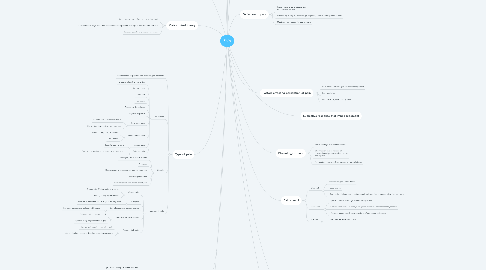
1. Subjective response that impair judgment
2. Nursing care
2.1. Prioritizing
2.1.1. Assess pt to achieve optimal Control pain
2.1.2. Combination of medical and complementary therapies
2.2. Assessing
2.2.1. Pt perception
2.2.1.1. Mc gill pain Question
2.2.1.2. Wong - baker face pain reting
2.2.2. Physical response
2.2.2.1. Sympathy nerve systems response
2.2.3. Behavior response
2.2.3.1. Culture factors- coping skills- fear - denial
2.3. Diagnosis- planning- implementing
2.3.1. Acute- chronic pain
2.3.2. Prevent side effect
2.3.3. Consider priorities
2.3.4. Explore misconceptions
2.4. Managing nursing care
2.4.1. Decreased respiratory rate and altered loc
2.5. Evaluation
2.5.1. Determined effectiveness of pain management strategies
2.6. Document
2.6.1. Sub - obj
2.6.2. Effect of intrvention
2.7. Continutiy of care
2.7.1. Teaching
2.7.2. Make referrals as needed
3. Complementary therapy
3.1. Acupuncture
3.2. Biofeedback
3.3. Distraction
3.4. Hypnotism
3.5. Relaxation techniques
3.5.1. Diaphragmatic breathing
3.5.2. Progressive muscle relaxation
3.5.3. Guided imagery or meditation
4. Transcutaneous electrical nerve stimulation
4.1. Low - voltage placed on pt
4.2. Avoid drug side effect
4.3. Allow pt control
4.4. Chronic benign , Acute postoperative
4.5. Disadvantage
4.5.1. Cost
4.5.2. Need to training
5. Surgery
5.1. Cordotomy
5.2. Nerurectomy
5.3. Sympathectomy
5.4. Rhizotomy
6. Routes of admission medications
6.1. Oral
6.2. Rectal
6.3. Transdermal
6.4. Intramuscular
6.5. Equianalgesic doses
6.6. Intravenous
6.6.1. Drip or bolts
6.6.2. Pt controlled analgesia
6.7. Subcutaneous
6.8. Intraspinal
6.9. Nerve blocks
7. Pain medication
7.1. Non opioid
7.1.1. Analgesics
7.2. Opioid
7.2.1. OST potent pain relieving drugs
7.3. Acetaminophen
7.4. NSAID
7.4.1. Act on peripheral nervous system
7.4.2. Analgesic ceiling
7.5. Adjuvant analgesics
7.5.1. Anticonvulsant
7.5.2. Antidepressants
7.5.3. Systemic anesthesia
7.5.4. Corticosteroids
7.5.5. CNS stimuli
7.5.6. Bisphosphonates
8. Factors affecting patient response to pain
8.1. Age - older -deny pain or self medicate
8.2. Sociocultural factors = family, community, culture
8.3. Psychology = emotional, past perception with pain, meaning of pain
8.4. Deficient knowledge = assess patient willingness to learn,evaluate level of learning
9. Type of pain
9.1. Sub response to physical and psychological stressors
9.2. Acute Pain
9.2.1. Temporary, less then 6 months
9.2.2. Sudden onset
9.2.3. Localized
9.2.4. Has cause
9.2.5. Caused by tissue injury
9.2.6. Physical response
9.2.7. Cutaneous pain
9.2.7.1. Injury to skin or superficial tissue
9.2.7.2. Sharp , burning , cutting, well localized
9.2.8. Deep somatic pain
9.2.8.1. Injury to deep body structures
9.2.8.2. Dull , difuse
9.2.9. Visceral pain
9.2.9.1. Injury to body organs
9.2.10. Referred pain
9.2.10.1. Start at one site but is perceived in another site
9.3. Chronic
9.3.1. Prolonged, more then 6 months
9.3.2. No cause
9.3.3. Unresponsive to conventional medical treatment
9.3.4. Psychology response
9.3.5. Non malignant pain or malignant pain
9.4. Neuropathic pain
9.4.1. Central pain
9.4.1.1. Damage to CNS or peripheral nerve
9.4.1.2. Burning or tingling sensation
9.4.2. Allodynia
9.4.2.1. Pain result from stimulus usually not causing pain
9.4.3. Complex regional pain syndrome
9.4.3.1. Extremity pain severe, diffuse and burning
9.4.4. Peripheral neuropathy pain
9.4.4.1. Diabetes or long term alcohol
9.4.4.2. Specific injury (trigeminal neuralgia)
9.4.5. Phantom limb pain
9.4.5.1. Surgical or traumatic removal of limb
9.4.5.2. Itching, tingling , pressure, burning, stabbing sensation
10. Gate control theory
10.1. Pain impulse travels from skin to spinal cord
10.2. Stimulations of large and small nerve fibers can open and close pain transmissions to brain
10.3. Possible genetic and sensory influence
11. Pain condition
11.1. Transduction
11.1.1. Change of noxious stimulus into electrical action potential stimulus
11.1.2. Send impulse transmitted by afferent a-delt afibers and small c nerve fibers throughout CNS
11.1.3. A fiber Rapid = Acute, sensation
11.1.4. C fiber slow = chronic , diffuse , dull aching
11.2. Transmission
11.2.1. Sending impulse from afferent neurons to spinal cord
11.2.2. Substance p sends impulse across synapses to travel to brain
11.3. Perception
11.3.1. Processing of pain impulse in thalamus and cerebral cortex
11.3.2. Pain threshold = ointment pain is recognized
11.3.3. Pain tolerance = amount and duration of pain person can stand before seeking care
11.4. Modulation
11.4.1. Body attempts to decrease perception of pain
11.4.2. Endorphins ( endogenous morphines ) bind with opiate receptors and inhibit release of substance p
12. Pain stimuli
12.1. Chemical
12.1.1. Ischemia: angina , bowl infarct
12.1.2. Tissue trauma
12.1.3. Inflammation, inflammatory mediator such as histamine, prostaglandins ( sore throat )
12.2. Mechanical
12.2.1. Spasm : ureteral colic , gallstones, kidney stone
12.2.2. Compression: invasiv tumor , Carl gunnel syndrome,compartment syndrome
12.2.3. Extreme muscle stretch or contractions (after a sprain or fracture)
12.3. Thermal
12.3.1. Contact with extreme heat or cold
